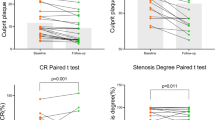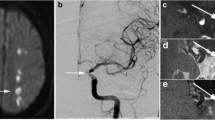Abstract
Purpose
Little is known about the natural history of intracranial atherosclerotic plaque enhancement and its clinical implications. Our objective was to investigate the value of follow-up high-resolution contrast-enhanced vessel wall MRI (VWMRI) for classifying culprit plaques in patients with intracranial atherosclerotic disease (ICAD).
Methods
Fourteen patients with symptomatic ICAD (50% females; median age 48 years) underwent serial 3T VWMRI. Fifty-five plaques were identified and graded based on the likelihood of having caused the ischemic event (non-culprit, indeterminate, culprit) and degree of enhancement (0, 1, 2) at baseline and follow-up (median follow-up, 140 days). For accuracy analysis, plaque enhancement at baseline and stable or increasing plaque enhancement at follow-up was tested to identify a culprit plaque, and areas under the receiver operating characteristic curves (AUCs) were compared.
Results
In 37/55 (67.3%) plaques, enhancement grade remained unchanged. Lack of enhancement was only seen in non-culprit plaques at baseline, and none developed enhancement over time. Enhancement never changed more than one grade. Thirty-seven percent (10/27) of non-culprit plaques that enhanced decreased in enhancement grade at follow-up, but no culprit plaques decreased in enhancement. AUC of baseline and follow-up plaque enhancement combined was significantly larger than AUC of baseline plaque enhancement alone to identify culprit plaques (0.733 vs. 0.567, p = 0.0001).
Conclusion
Contrast enhancement of ICAD can persist months after the ischemic event. Lack of enhancement at baseline or a decrease in enhancement at follow-up suggests that the plaque is not culprit. Persistent enhancement from baseline to follow-up improves accuracy in identifying culprit plaques.




Similar content being viewed by others
References
GBD 2013 Mortality and Causes of Death Collaborators (2015) Global, regional, and national age-sex specific all-cause and cause-specific mortality for 240 causes of death, 1990–2013: a systematic analysis for the Global Burden of Disease Study 2013. Lancet 385:117–171
Murray CJ, Vos T, Lozano R, Global Burden of Diseases, Injuries, and Risk Factors Study 2010 (GBD 2010) and the GBD Stroke Experts Group et al (2014) Global and regional burden of stroke during 1990–2010: findings from the Global Burden of Disease Study 2010. Lancet 383:245–254
Arenillas JF (2011) Intracranial atherosclerosis: current concepts. Stroke 42(1 Suppl):S20–S23
Bos D, Portegies ML, van der Lugt A et al (2014) Intracranial carotid artery atherosclerosis and the risk of stroke in whites: the Rotterdam study. JAMA Neurol 71:405–411
Bodle JD, Feldmann E, Swartz RH, Rumboldt Z, Brown T, Turan TN (2013) High-resolution magnetic resonance imaging: an emerging tool for evaluating intracranial arterial disease. Stroke 44:287–292
Qiao Y, Steinman DA, Qin Q, Etesami M, Schär M, Astor BC, Wasserman BA (2011) Intracranial arterial wall imaging using three-dimensional high isotropic resolution black blood MRI at 3.0 tesla. J Magn Reson Imaging 34:22–30
Portanova A, Hakakian N, Mikulis DJ, Virmani R, Abdalla WM, Wasserman BA (2013) Intracranial vasa vasorum: insights and implications for imaging. Radiology 267:667–679
Qiao Y, Zeiler SR, Mirbagheri S, Leigh R, Urrutia V, Wityk R, Wasserman BA (2014) Intracranial plaque enhancement in patients with cerebrovascular events on high-spatial-resolution MR images. Radiology 271:534–542
Vakil P, Vranic J, Hurley MC, Bernstein RA, Korutz AW, Habib A, Shaibani A, Dehkordi FH, Carroll TJ, Ansari SA (2013) T1 gadolinium enhancement of intracranial atherosclerotic plaques associated with symptomatic ischemic presentations. AJNR Am J Neuroradiol 34:2252–2258
Vergouwen MD, Silver FL, Mandell DM, Mikulis DJ, Swartz RH (2011) Eccentric narrowing and enhancement of symptomatic middle cerebral artery stenoses in patients with recent ischemic stroke. Arch Neurol 68:338–342
Lou X, Ma N, Ma L, Jiang WJ (2013) Contrast-enhanced 3T high-resolution MR imaging in symptomatic atherosclerotic basilar artery stenosis. AJNR Am J Neuroradiol 34:513–517
Skarpathiotakis M, Mandell DM, Swartz RH, Tomlinson G, Mikulis DJ (2013) Intracranial atherosclerotic plaque enhancement in patients with ischemic stroke. AJNR Am J Neuroradiol 34:299–304
van der Kolk AG, Zwanenburg JJ, Brundel M et al (2011) Intracranial vessel wall imaging at 7.0-T MRI. Stroke 42:2478–2484
DeLong ER, DeLong DM, Clarke-Pearson DL (1988) Comparing the areas under two or more correlated receiver operating characteristic curves: a nonparametric approach. Biometrics 44:837–845
Jeziorska M, Woolley DE (1999) Neovascularization in early atherosclerotic lesions of human carotid arteries: its potential contribution to plaque development. Hum Pathol 30:919–925
Libby P, Ridker PM, Maseri A (2002) Inflammation and atherosclerosis. Circulation 105:1135–1143
Wasserman BA, Smith WI, Trout HH 3rd et al (2002) Carotid artery atherosclerosis: in vivo morphologic characterization with gadolinium-enhanced double-oblique MR imaging initial results. Radiology 223:566–573
Harteveld AA, van der Kolk AG, van der Worp HB, Dieleman N, Siero JCW, Kuijf HJ, Frijns CJM, Luijten PR, Zwanenburg JJM, Hendrikse J (2017) High-resolution intracranial vessel wall MRI in an elderly asymptomatic population: comparison of 3T and 7T. Eur Radiol 27:1585–1595
Power S, Matouk C, Casaubon LK, Silver FL, Krings T, Mikulis DJ, Mandell DM (2014) Vessel wall magnetic resonance imaging in acute ischemic stroke: effects of embolism and mechanical thrombectomy on the arterial wall. Stroke 45:2330–2334
Burke AP, Farb A, Malcom GT, Liang YH, Smialek JE, Virmani R (1999) Plaque rupture and sudden death related to exertion in men with coronary artery disease. JAMA 281:921–926
McCarthy MJ, Loftus IM, Thompson MM et al (1999) Angiogenesis and the atherosclerotic carotid plaque: an association between symptomatology and plaque morphology. J Vasc Surg 30:261–268
Funding
No funding was received for this study
Author information
Authors and Affiliations
Corresponding author
Ethics declarations
Conflict of interest
YQ and BAW have a patent pending (No. 13/922,111) for the 3D black blood MR imaging technique used in this study.
Ethical approval
All procedures performed in studies involving human participants were in accordance with the ethical standards of the institutional and/or national research committee and with the 1964 Helsinki declaration and its later amendments or comparable ethical standards.
Informed consent
Informed consent was obtained from all individual participants included in the study
Additional information
Publisher’s note
Springer Nature remains neutral with regard to jurisdictional claims in published maps and institutional affiliations.
Rights and permissions
About this article
Cite this article
Kwee, R.M., Qiao, Y., Liu, L. et al. Temporal course and implications of intracranial atherosclerotic plaque enhancement on high-resolution vessel wall MRI. Neuroradiology 61, 651–657 (2019). https://doi.org/10.1007/s00234-019-02190-4
Received:
Accepted:
Published:
Issue Date:
DOI: https://doi.org/10.1007/s00234-019-02190-4




